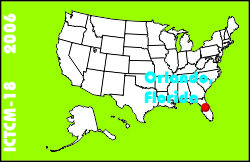
Electronic Proceedings of the Eighteenth Annual International Conference on Technology in Collegiate MathematicsOrlando, Florida, March 16-19, 2006Paper C031Mathematical Modeling for Game Design |
Paul BouthellierDepartment of Mathematics and Computer Science University of Pittsburgh-Titusville Titusville, PA 16354 Phone: (814) 827-4432 Fax: (814) 827-5574 pbouthe@pitt.edu list of all papers by this author | Saeed DubasDepartment of Mathematics and Computer Science University of Pittsburgh-Titusville Titusville, PA 16354 Phone: (814) 827-5672 Fax: (814) 827-5574 dubasis@pitt.edu list of all papers by this author |
| Click to access this paper: |
ABSTRACT
Description of Game:A shooting game using Flash is designed. In each level 10 moving targets are created and are 'hit' by the mouse-which is represented by a crosshair. After all ten targets are hit the next level is loaded in which the targets move faster. The player is given twenty shots in the first level and a bonus of twenty additional shots for each level completed. The game is concluded when the player runs out of shots.
Mathematics Involved:
Targets may be created using recursive methods (such as the Koch snowflake using Geometer's Sketchpad), in packages such as Swift 3D, or using lines, symmetry, and Bezier curves in Flash.
To control the paths of the objects the following have been used: linear equations, Bezier curves, interpolation polynomials, and trigonometric functions with varying frequencies, amplitudes, and phases. By scaling each target one can create the illusion of three-dimensional depth.
To determine if a player has hit a target it is necessary to determine if a point, represented by the crosshair, is inside the mathematical description of the target. As the target can be a two-dimension projection of a rotating three-dimensional object, this can lead to interesting mathematical problems.
More complicated target trajectories can be created by modeling their paths using realistic gravity, masses, inertia, cross-sectional areas, lift, drag, and wind. Such trajectories require equations and concepts from physics and an atmospheric model (which one can get from NASA).
Keyword(s): applications, modeling
